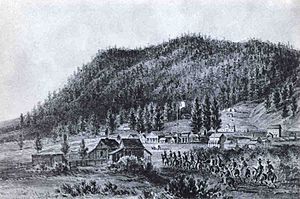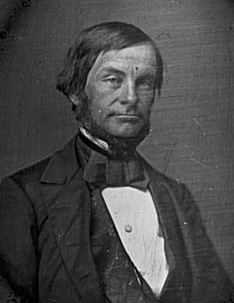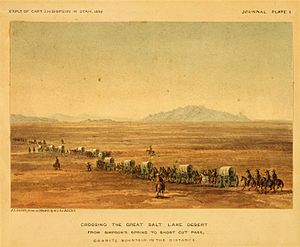James H. Simpson facts for kids
James Hervey Simpson (born 1813, died 1883) was an important officer in the United States Army. He was part of a special group called the Corps of Topographical Engineers, who were like expert mapmakers and explorers for the army. Simpson helped explore and map many parts of the American West, especially before the American Civil War.
Contents
Early Life and Military Training
James Hervey Simpson was born on March 9, 1813, in New Brunswick, New Jersey. His parents were John Simpson and Mary Brunson.
When he was older, James went to the United States Military Academy at West Point, which is a famous school for training army officers. He graduated from West Point in 1832. After graduating, he joined the 3rd U.S. Artillery. He also served in the Second Seminole War, which was a conflict in Florida. In 1837, he was promoted to first lieutenant.
Joining the Topographical Engineers
In 1838, the U.S. Army created a new department called the Topographical Engineers. This group was different from the regular United States Army Corps of Engineers. Their main job was to explore, survey, and map the land, which was very important for the growing country.
Simpson was one of the officers chosen to join this new group. He worked as an assistant helping to build harbors on Lake Erie. The next year, he helped build roads in Florida and surveyed lakes in Wisconsin and Ohio. From 1845 to 1847, he was in charge of the harbor in Erie.
Exploring the American West
New Mexico Expedition (1849)
In 1849, Lieutenant Simpson went on his first big trip into the American West. He was part of an expedition led by Colonel John James Abert. Simpson's job was to survey a road from Fort Smith, Arkansas to Santa Fe, New Mexico.
After that, he joined a military mission against the Navajo people, led by John M. Washington. Simpson made sure to include drawings and artwork by the brothers Edward and Richard Kern in his reports. Soon after, he became the Chief Topographical Engineer for the Ninth Military Department, which was based in Santa Fe.
Other Surveying Missions
In the spring of 1851, Simpson traveled to the Minnesota Territory to survey and improve roads there. In 1853, he was promoted to captain. Later that year, he moved to Florida, where he oversaw survey work for the U.S. Coast Survey.
Utah Expedition (1858–1859)

During the winter of 1857-1858, Simpson was asked to help the army forces involved in the Utah War. He prepared maps for the upcoming military plans while stationed at Fort Leavenworth and Fort Kearny.
On July 3, 1858, Simpson left for Camp Floyd, arriving on August 19. He was ordered to survey a wagon road between Camp Floyd and Fort Bridger. After finishing that, Simpson explored the Great Salt Lake Desert in October. On May 2, 1859, Simpson led a larger expedition with 64 men.
His photographer, Samuel C. Mills, took some of the earliest photos of the trail. Simpson's new Central Nevada Route became very important for moving mail, goods, and people between the eastern states and California. This was especially true when the American Civil War started and closed the southern stagecoach routes.
Companies like George Chorpenning's mail line and the famous Pony Express quickly started using Simpson's route. In 1861, the Transcontinental Telegraph line was built along this route, which made the Pony Express no longer needed. Later, Wells Fargo used Simpson's route until 1869, when the Transcontinental Railroad was completed, changing transportation forever.
Civil War Service
During the American Civil War, James Simpson served as a colonel in the 4th New Jersey Volunteer Infantry. He was captured during the Battle of Gaines' Mill. After being released, he resigned from his volunteer position on August 24, 1862, to return to his rank of major in the Corps of Topographical Engineers. He was then put in charge of expanding and improving the defenses for Cincinnati, Ohio. For his service during the war, Simpson was given the honorary rank of brigadier general.
Later Years and Legacy
After the Civil War, Simpson became the chief engineer for the Interior Department. He oversaw the construction of the Transcontinental Railroad. Once the railroad was finished, his own Central Nevada Route became less important for travel.
In 1880, he retired to St. Paul, Minnesota. James Hervey Simpson passed away there on March 2, 1883.
Several places are named after him, including the Simpson Park Mountains in central Nevada, a small mountain range in west-central Utah called the Simpson Mountains, and the Simpson Springs Pony Express Station.




